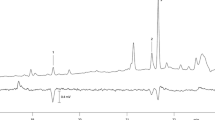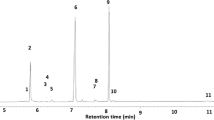Abstract
Analysis by gas chromatography (GC) and GC-mass spectroscopy disclosed that droplets of anal fluid produced by second-instar western flower thrips,Frankliniella occidentalis (Pergande) (Thysanoptera: Thripidae), contain a two-component alarm pheromone, comprised of decyl acetate and dodecyl acetate, in a molar ratio of approximately 1.5∶1. Both nymphs and adults responded to the pheromone by walking away from the source. The synthetic pheromone was active at a concentration of 1.0 ng, and the proportions of insects responding to the pheromone, but not the distances moved, increased with increasing dose. Each component was active alone, although at low doses, the response to decyl acetate was less than to either dodecyl acetate or the blend. The pheromone also induced some second instars to drop from leaves and reduced oviposition by adult females in both two-choice and nochoice experiments. Because the response of western flower thrips to the alarm pheromone is relatively weak, the potential for its use in pest management is limited, unless it is used in conjunction with other control measures.
Similar content being viewed by others
References
Blum, M.S., 1969. Alarm pheromones.Annu. Rev. Entomol. 14:57–80.
Blum, M.S. 1985. Alarm pheromones,in Comprehensive Insect Physiology, Biochemistry and Pharmacology, Vol. 9. G.A. Kerut and L.I. Gilbert (eds.) Pergamon Press, Oxford, UK.
Borden, J.H., Chong, L.J., andLindgren, B.S. 1990. Redundancy in the semiochemical message required to induce attack on lodgepole pines by the mountain pine beetle,Dendroctonus ponderosae Hopkins (Coleoptera: Scolytidae).Can. Entomol. 122:769–777.
Bowers, W.S., Nault, L.R., Webb, R.E. andDutky, S.R. 1972. Aphid alarm pheromone: Isolation, identification, synthesis.Science 177:1121–1123.
Calabrese, E.J., andSorensen, A.J. 1978. Dispersal and recolonization byMyzus persicae following aphid alarm pheromone exposure.Ann. Entomol. Soc. Am. 71:181–182.
Calam, D.H., andYoudeowei, A. 1968. Identification and functions of secretion from the posterior scent gland of fifth instar of the bugDysdercus intermedius.J. Insect Physiol. 14:1147–1158.
Crespi, B.J. 1986a. Size assessment and alternative fighting tactics inElaphrothrips tuberculatus (Insecta: Thysanoptera).Anim. Behav. 34:1324–1335.
Crespi, B.J. 1986b. Territoriality and fighting in a colonial thrips,Hoplothrips pedicularius, and sexual dimorphism in Thysanoptera.Ecol. Entomol. 11:119–130.
Dawson, G.W., Gibson, R.W., Griffiths, D.C., Pickett, J.A., Rice, A.D., andWoodcock, C.M. 1982. Aphid alarm pheromone derivatives affecting settling and transmission of plant viruses.J. Chem. Ecol. 8(11): 1377–1388.
Griffiths, D.C., andPickett, J.A. 1980. A potential application of aphid alarm pheromones.Entomol. Exp. Appl. 27:199–201.
Griffiths, D.C., Dawson, G.W., Pickett, J.A., andWoodcock, C. 1983. Uses of the aphid alarm pheromone and derivatives.Int. Cong. Plant Protect. Proc. 1:272.
Grizzle, J.E., Starmer, C.F., andKoch, G.G. 1969. Analysis of categorical data by linear models.Biometrics 25:189–195.
Howard, D.F., Blum, M.S., andFales, M.F. 1983. Defense in thrips: forbidding fruitiness of a lactone.Science 220:335–336.
Howard, D.F., Blum, M.S., Jones, T.H., Fales, M.F., andTomalski, M.D. 1987. Defensive function and chemistry of the anal exudate of the cuban laural thripsGynaikothrips ficorun (Marchal).Phytophaga 1:163–170.
Ishiwatari, T. 1974. Studies on the scent of stink bugs (Hemiptera: Pentatomidae) I. Alarm pheromone activity.Appl. Entomol. Zool. 9:153–158.
Kearns, R.S., andYamamoto, R.T. 1981. Maternal behavior and alarm response in the eggplant lace bugGargaphia solani Heidemann (Tingidae: Heteroptera).Psyche 88:215–230.
Levinson, H.Z., andBar Ilan, A.R. 1971. Assembling and alerting scents produced by the bedbugCimex lectulariusL.Experientia 27:102–103.
Levinson, H.Z., Levinson, A.R., Muller, B., andSteinbrecht, R.A. 1974. Structure of sensilla, olfactory perception, and behavior of the bedbug,Cimex lectularius, in response to its alarm pheromone.J. Insect Physiol. 20:1231–1248.
Linn, C.E., Jr., Bjostad, L.B., Wu, J.W., andRoelofs, W.L. 1984. Redundancy in a chemical signal: Behavioral responses of maleTrichoplusia ni to a 6-component sex pheromone blend.J. Chem. Ecol. 10:1635–1658.
Lockwood, J.A., andStory, R.N. 1987. Defensive secretion of the southern green stinkbug (Hemiptera: Pentatomidae) as an alarm pheromone.Ann. Entomol. Soc. Am. 80:686–691.
Maschwitz, U., andGutmann, C. 1979. Trail and alarm pheromones inElasmucha grisea (Heteroptera: Acanthosomidae)Insectes Soc. 26:101–111.
Montgomery, M.E., andNault, L.R. 1977. Aphid alarm pheromones: Dispersion ofHyadaphis erysimi andMyzus persicae.Ann. Entomol. Soc. Am. 70:669–672.
Myers, J.L. 1979. Fundamentals of Experimental Design, 3rd ed. University of Massachusetts, Amherst, Massachusetts.
Nault, L.R., Wood, T.K., andGoff, A.M. 1974. Treehopper (Membracidae) alarm pheromones.Nature 249:387–388.
Peterson, B.S. 1990. The effect of host plant on the biological control of western flower thrips by the predatory mite,Amblyseius cucumeris. MPM thesis. Simon Fraser University, Burnaby, British Columbia.
Suzuki, T., Haga, K., andKuwahara, Y., 1986. Anal secretions of thrips: I. Identification of perillene fromLeeeuwenia pasanii (Thysanoptera: Phlaeothripidae).Appl. Entomol. Zool. 21(3):461–466.
Suzuki, T., Haga, K., Kodama, S., Watanabe, K., andKuwahara, Y. 1988. Secretion of thrips: II. Secretions of three gall-inhabiting thrips (Thysanoptera: Phlaeothripidae).Appl. Entomol. Zool. 23(3):291–297.
Suzuki, T., Haga, K., Leal, W.S., Kodama, S., andKuwahara, Y. 1989. Secretions of thrips. IV. Identification ofβ-acaridial from three gall-forming thrips (Thysanoptera: Thripidae).Appl. Entomol. Zool. 24(2):222–228.
Teerling, C.R.,Gillespie, D.R., andBorden, J.H. 1993. Utilization of western flower thrips alarm pheromone as a prey-finding kairomone by predators.Can. Entomol. In press.
Terry, L.I., andGardner, D. 1990. Male mating swarms inFrankliniella occidental (Pergande) (Thysanoptera: Thripidae).J. Insect Behav. 3(1):133–141.
Wholers, P. 1981a. Aphid avoidance of plants contaminated with alarm pheromone (E)-β-farnesene.Z. Angew. Entomol. 92:329–336.
Wholers, P. 1981b. Effects of the alarm pheromone (E)-β-farnesene on dispersal behaviour of the pea aphidAcyrthosiphon pisum.Entomol. Exp. Appl. 29:117–124.
Wood, T.K. 1976. Alarm behavior of brooding femaleUmbonia crassicornis (Homoptera: Membracidae).Ann. Entomol. Soc. Am. 69:340–344.
Zar, J.H. 1984. Biostatistical Analysis, 2nd ed. Prentice Hall, Englewood Cliffs, New Jersey.
Author information
Authors and Affiliations
Rights and permissions
About this article
Cite this article
Teerling, C.R., Pierce, H.D., Borden, J.H. et al. Identification and bioactivity of alarm pheromone in the western flower thrips,Frankliniella occidentalis . J Chem Ecol 19, 681–697 (1993). https://doi.org/10.1007/BF00985001
Received:
Accepted:
Issue Date:
DOI: https://doi.org/10.1007/BF00985001




